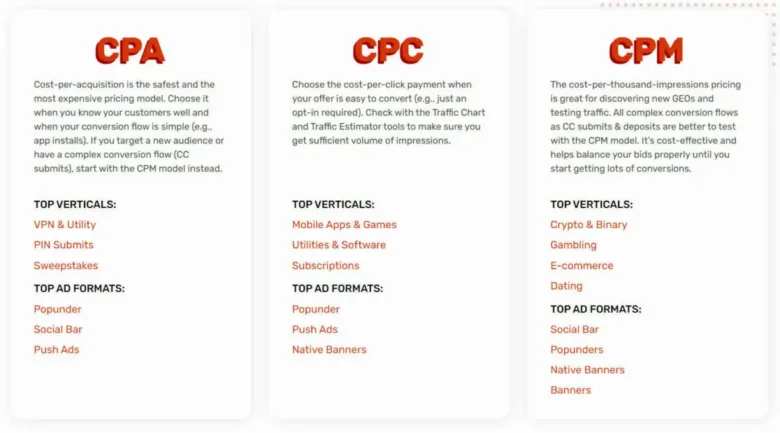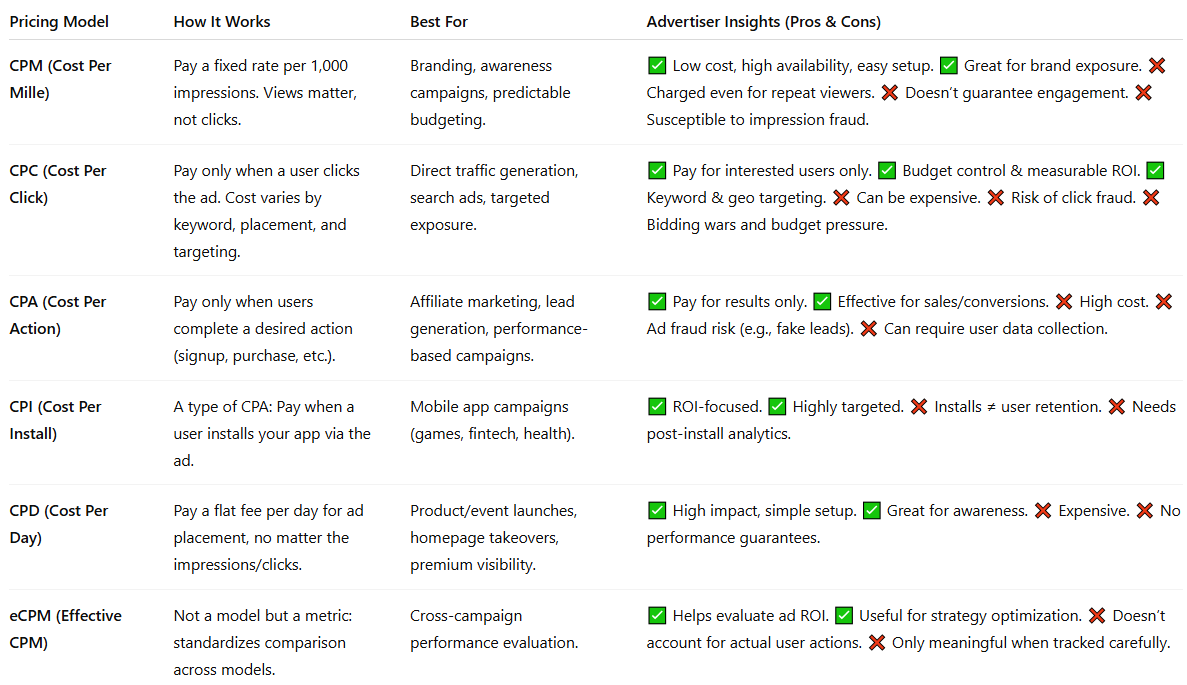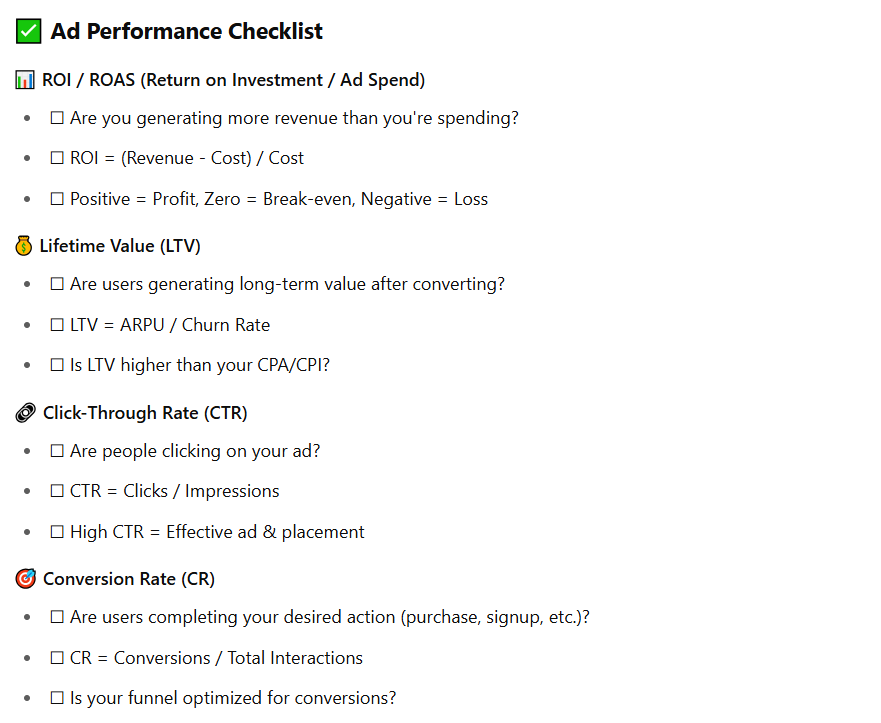In the rapidly evolving world of digital marketing, choosing the right advertising pricing model is crucial for achieving a strong return on investment (ROI). Whether you’re a small business owner or managing a major online campaign, understanding how internet advertising pricing models work will help you allocate budget effectively and measure success accurately.
This guide explores various advertising pricing models, including common ones like CPM, CPC, CPA, and more specialized options like eCPM, CPI, and CPD. We’ll also compare the pricing models available for online advertisers and explain how each fits into your marketing goals. So before you chose the best three-lettered option for your campaigns, let’s start from the RSG one: Ready? Steady? Go!
What Are Advertising Pricing Models?
Generally, advertising pricing models are frameworks that determine how advertisers are charged for placing ads online. In the context of digital marketing, they help define the cost structure and goals of an advertising campaign. These pricing models in digital advertising allow marketers to align spending with desired outcomes—whether that’s generating impressions, clicks, conversions, or app installs.
Digital advertising pricing models are typically chosen based on campaign objectives, audience behavior, and platform preferences. For example, an e-commerce brand looking for direct sales may prefer a CPA model, while a media company seeking broader exposure might opt for CPM. See how Adsterra protects advertisers from fraud traffic and other malicious activities.
Try now and get the best combo for your campaigns.
Common Advertising Pricing Models Explained
To better compare the pricing models available for online advertisers, it’s helpful to break them down one by one.
What Is CPM (Cost Per Mille) or CPI (Cost Per Impression) Advertising?
CPM is a pricing model in which an advertiser is charged a flat rate per 1,000 ad impressions. As a result, CPM is also known as cost per thousand. The CPM model heavily relies on the number of times the ad was displayed; it doesn’t matter if the user clicked on the ad or interacted with it.
For advertisers, it’s ideal for display and branding campaigns. CPM is the best option for publishers because it provides predictable revenue and measurable results. The CPM protocol usually guarantees a certain number of impressions, which determines the cost. For example, the advertiser will pay $200 if the website has a CPM rate of $2 and guarantees 100,000-page impressions for the advertisement.
Pros for advertisers
-
It is the cheapest form of advertising and is ideal if you are on a tight budget and require consistent pricing.
-
It’s simple to launch and manage: Pay for 1,000 impressions and then forget about them.
-
CPM is always profitable if the ad generates a high click-through rate.
-
It fosters brand awareness over performance.
-
There is a lot of ad inventory available for this pricing model.
Cons for advertisers
-
Even if the same person sees the ad multiple times, you’ll still be charged.
-
It is a quantitative rather than qualitative benchmark.
-
There’s a risk of impression fraud.
Pros for publishers
-
In comparison to CPC, it carries a low risk.
-
You don’t have to worry a lot about click-through rates (CTR), though they matter.
-
You can measure and verify viewership.
-
The income stream from CPM is very predictable.
Cons for publishers
-
It requires a lot of traffic or highly-demanded traffic.
-
You will receive lower-paying advertisements.
-
You’re not compensated for clicks you generate.
What is the cost of an impression?
The cost-per-impression pricing model is popular for digital advertising because of its efficiency, verifiable distribution, and ability to target precisely. Geo-targeting, segment targeting, and ad format affect the average cost per thousand impressions. In addition, the actual cost of CPMs is determined by the advertising material’s placement.
CPC (Cost Per Click) and PPC (Pay Per Click)
An ad pricing model is a system a publishing platform chooses to charge an advertiser for displaying an announcement. The nature of a pricing model often hides in its name: for example, cost-per-click literally means you will be paying for every user that clicks the ad.
This pricing model can be viewed as a payment for targeted exposure because users express interest in a given offer by clicking on the ad.
It’s up to each advertiser to set their ‘monthly budget’ and ‘maximum cost per click’ by keyword. Monthly CPC budgets often range from $50 to $500,000 and up.
Pros for advertisers
-
The ad is seen for free by thousands even if no one clicks on it.
-
Their website receives pre-warmed, engaged traffic.
-
The return on investment is measurable: You can quickly tell what works and what doesn’t.
-
The budget is under your control.
-
Site-blocking filters are available.
-
Specific keywords and GEO targeting are available.
Cons for advertisers
-
Bidding wars may occur.
-
It can be costly and requires a moderate budget.
-
Risk of click fraud, fake clicks, and ghost traffic.
See how Adsterra protects advertisers from fraud traffic and other malicious activities.
Pros for publishers
-
Measurable ROI makes it easier to attract more advertisers.
-
You can collect more information about your viewers and easily track their click-through and engagement rates.
-
It carries a moderate level of risk.
Cons for publishers
-
Often requires a high click-through rate
-
Revenue is often unpredictable because publishers don’t know how many people will click on the ad
-
When misused (like when you place ads near the navigation buttons ignoring UX), it drives visitors away from your website.
What is the cost of a click?
A click could cost anywhere from one cent to ten dollars. Google AdWords, for example, charges $2.58 per click on average across all industries on the search network. The average CPC for display networks is around $0.58. Some of Bing’s and AdWords’ most expensive keywords could cost up to $50 per click.
On Adsterra, the CPC starts from $0.001. Register and create your first cost-effective campaign.
For advertisers, CPC is determined by the type of ad, its placement on the website, the targeted industry, and the amount of advertising booked. For example, banner ad clicks cost more than text link clicks. The cost per click for ads on the home page is higher than for ads on sub-pages. CPC will be much higher in the financial industry due to increased competition. For publishers, the CPC is determined by the website’s quality, click-through rate (CTR), platform coverage, and relevance to the promotional materials being offered to website visitors.
CPA (Cost Per Action)
The cost-per-action (CPA) pricing model is the most common in affiliate marketing. It is a pricing model where advertisers only pay when users perform a targeted action such as installing, clicking, or converting to a lead. What is the difference between cost-per-action (CPA), cost-per-acquisition (CPA), cost-per-lead (CPL), and cost-per-installation (CPI) advertising?
In the cost-per-lead pricing model, advertisers pay when a user views their ad on a website, clicks on it, and then takes further action like leaving their email address. Because a user must complete an action on the advertiser’s site, cost-per-lead takes the process one step further. Advertisers can charge for specific actions such as downloading a PDF, signing up for a newsletter, becoming a member, watching a video, taking a survey, and so on. This metric is set when creating a campaign.
CPI is a type of CPA model in which advertisers pay a fixed rate per app installation. App marketers who focus on traffic quality rather than quantity to attract highly motivated traffic often use the cost-per-install model. Because of its competitive advantages, the CPI pricing model is prevalent in the mobile ecosystem. Even though the cost per download is typically higher than the cost per click, the budgeting appears to be effective because the client pays for the actual user rather than the ad impression.
Pros for advertisers
-
The publisher takes on all of the risks.
-
You only pay for results, so no action means no payment.
-
Even without clicks or actions, the ad receives exposure.
-
It generates sales opportunities.
Cons for advertisers
-
It is the most expensive pricing model
-
CPL requires disclosing sensitive information.
-
Ad fraud is a real possibility. You should partner only with reliable networks and publishers, as fake form filling is a real possibility.
Pros for publishers
-
It’s a less predictable source of income.
-
You might be in charge of making the ad program successful and determining when and where the ad should run.
-
Higher revenue.
Cons for publishers
-
Tracking can be difficult. When a user clicks on the ad, they are taken to an external page, and you have no way of knowing whether the clicks have resulted in a completed action.
-
Clicks are not compensated.
-
Advertisers may intentionally design ads that do not convert in order to get free branding.
-
Cookie fraud can happen, such as the expiration or deletion of cookies, resulting in a loss of payment.

Other Pricing Models: eCPM, CPI, CPD
Beyond the commonly used models, there are several alternative pricing models in digital advertising that suit more specialized needs.
eCPM (Effective Cost Per Mille)
eCPM is a calculated metric, not a pricing model per se, but it’s critical for comparing the efficiency of multiple campaigns across different pricing formats. It helps advertisers translate results into a standard CPM value for cross-campaign analysis.
Formula:
eCPM = (Total Earnings / Total Impressions) × 1000
Use case:
You might run a CPC and CPA campaign simultaneously but use eCPM to compare which delivers better value per thousand impressions.
Why it matters:
It’s especially valuable for publishers and ad networks looking to optimize their inventory monetization.
CPI (Cost Per Install)
CPI (Cost Per Install) is already explained above a bit. Long story short, it’s widely used in mobile app marketing. Advertisers are charged only when a user installs their app as a direct result of an ad click.
How it works:
If the CPI is $3.00, each app installation costs you three dollars.
Best for:
-
Mobile app launches
-
Game developers
-
Fintech and health apps
Pros:
-
Highly targeted
-
Results-focused
-
Easy to calculate ROI
Cons:
-
Install ≠ user retention
-
Requires post-install analytics to measure value
CPI is a pricing model tailored for the mobile ecosystem and is increasingly popular as mobile ad spend grows.
CPD (Cost Per Day)
CPD (Cost Per Day) is a fixed-price model where advertisers pay for ad placements for a full day, regardless of impressions or clicks. It’s often used on premium sites or platforms offering high-visibility spots.
How it works:
You pay a daily rate, for example, $500/day, and your ad is featured in a prominent position (e.g., homepage takeover).
Best for:
-
Product or event launches
-
Takeover ads
-
Premium brand campaigns
Pros:
-
High exposure and impact
-
Ideal for awareness goals
-
Set-and-forget simplicity
Cons:
-
Expensive
-
No performance-based pricing
While CPD is less common than other internet advertising pricing models, it remains a staple for major branding initiatives.
Compare the Pricing Models Available for Online Advertisers

How to Choose the Right Online Advertising Pricing Model
Knowing how to choose the right online advertising pricing model depends on your business objectives, campaign structure, and budget flexibility. Here’s how to navigate the decision process.
1: Define Your Primary Goal.
-
Want visibility and awareness? → Consider CPM or CPD
-
Want site visits or engagement? → Choose CPC
-
Want conversions (sales, sign-ups)? → Opt for CPA
-
Promoting a mobile app? → Use CPI
2: Assess Your Budget.
-
CPC and CPA offer performance-based cost control.
-
CPD and CPM require larger budgets but provide broader exposure.
3: Evaluate Your Tracking Capabilities.
-
CPA and CPI require precise tracking.
-
CPC and CPM are simpler to implement but give less insight into post-click behavior.
4: Consider Your Platform.
-
Google Ads supports CPC, CPM, CPA, and more.
-
Facebook and Instagram support CPC, CPM, and CPA.
-
Mobile ad networks are ideal for CPI models.
-
Premium content sites often offer CPD placements.
5: Analyze Historical Performance.
If you’ve run past campaigns, use data to calculate eCPM across models to understand which format provides the best ROI.
Final Tip:
Your choice doesn’t have to be exclusive. Many advertisers run multi-model campaigns (e.g., using CPM for awareness and CPA for retargeting) for a well-rounded strategy.

Conclusion
As digital marketing continues to grow in complexity, advertisers must understand and evaluate the available pricing models in online advertising to make smart budget decisions. Each model serves a unique purpose—whether that’s generating awareness, driving engagement, or securing conversions. The best approach is to align your pricing model with your marketing objective and make decisions based on clear data. Blending several pricing structures can also offer optimal performance when done strategically.
With a thoughtful approach, online advertising pricing models become powerful tools for scaling growth, optimizing spend, and reaching the right audience at the right time. Adsterra is to offer all these opportunities to you, all you have to do is join!
Advertising Pricing Models FAQ
There are several advertising pricing models used across digital platforms: CPM (Cost Per Mille), CPC (Cost Per Click), CPA (Cost Per Action), CPI (Cost Per Install), CPD (Cost Per Day), RPM/eCPM (Revenue/Effective Cost Per Mille).
Each model reflects different goals—from maximizing reach to ensuring measurable ROI. Understanding what are the available pricing models in online advertising helps advertisers tailor strategies for better outcomes.
Whether CPC or CPM is better depends on your campaign goals:
– Choose CPC if your objective is user engagement or traffic. You only pay when someone interacts, making it cost-effective for performance-driven campaigns. This model also offers better transparency into what you’re paying for
– Choose CPM if your goal is brand visibility and reach. It ensures your ad gets seen, which is essential for awareness-building and product launches
In many cases, combining both in a full-funnel strategy is the most effective choice.
The best model varies on a bunch of factors, main of which is your goal. CPA fits if you only pay for successful outcomes, like leads or purchases. CPC is another advertiser-friendly model, as you control spending based on actual engagement. These models provide clear ROI and minimize risk. CPM or CPD are also beneficial. These models guarantee revenue based on impressions or time, regardless of user interaction.
RPM (Revenue Per Mille)—also referred to as eCPM when used by advertisers—is most useful when you want to evaluate the performance of ad inventory or campaigns across different pricing models. It provides a common metric that allows publishers to measure earnings per 1,000 impressions, no matter the original pricing format (CPC, CPA, or CPM).
